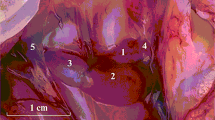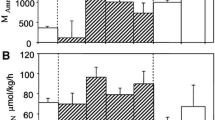Summary
Respiration rates, hemolymph acid-base variables, and metabolite levels were measured in the land snail Oreohelix during a brief period of estivation (4 days) and during exposure of non-estivating snails to elevated levels of ambient CO2 (34 and 58 mmHg). Respiration rate dropped during entry into estivation reflecting decreased glycolytic flux. Analyses of metabolite levels in foot muscle and digestive gland tissues demonstrated that glycolytic control during early estivation was primarily vested in pyruvate kinase. Relative to control values, the mass action ratio (MAR) of this reaction decreased by a factor of 4 in the foot muscle and by a factor of 2.7 in the digestive gland, reflecting inhibition of this enzyme in both tissues. No other glycolytic reaction appeared to be inhibited. Exposure of non-estivating snails to artificial hypercapnia resulted in extracellular acid-base conditions similar to those seen during estivation and also promoted a reduction in respiration rate. However, the points of glycolytic control were different: artificial hypercapnia resulted in inhibition of phosphofructokinase in foot muscle and hexokinase in digestive gland. Furthermore, elevated ambient CO2 had no effect on the MAR of the pyruvate kinase reaction in non-estivating snails. These results suggest that the action of extracellular acid-base variables alone cannot fully explain the down-regulation of glycolysis which occurs during estivation in this land snail.
Similar content being viewed by others
Abbreviations
- ADP :
-
adenosine 5'-diphosphate
- AEC :
-
adenylate energy charge
- AMP :
-
adenosine 5'-monophosphate
- ANOVA :
-
analysis of variance
- ATP :
-
adenosine 5'-triphosphate
- CCO2 :
-
total content of carbon dioxide
- EDTA :
-
ethylenediamine tetraacetic acid (disodium salt)
- AG o :
-
change in molar standard Gibbs energy
- IMP :
-
inosine 5'-monophosphate
- K a :
-
activation constant
- K eq :
-
equilibrium constant
- K m :
-
Michaelis constant
- MAR :
-
mass action ratio
- P :
-
probability
- PCA :
-
perchloric acid
- PCO2 :
-
partial pressure of carbon dioxide
- pH i :
-
intracellular pH
- P i :
-
inorganic phosphate
- r :
-
Spearman's coefficient of rank correlation
- SD :
-
standard deviation
References
Barnhart MC (1986a) Control of acid-base status in active and dormant land snails, Otala lactea (Pulmonata, Helicidae). J Comp Physiol B 156:347–354
Barnhart MC (1986b) Respiratory gas tension and gas exchange in active and dormant land snails, Otala lactea. Physiol Zool 59:733–745
Barnhart MC (1989) Respiratory acidosis and metabolic depression in dormant invertebrates. In: Malan A, Canguilhem B (eds) Living in the cold II. John Libbey Eurotext, London, pp 321–331
Barnhart MC, McMahon BR (1987) Discontinuous carbon dioxide release and metabolic depression in dormant land snails. J Exp Biol 128:123–138
Barnhart MC, McMahon BR (1988) Depression of aerobic metabolism and intracellular pH by hypercapnia in land snails, Otala lactea. J Exp Biol 138:289–299
Bergmeyer HU (1983) Methods of enzymatic analysis. Verlag Chemie, Weinheim
Brooks SPJ, Storey KB (1990a) cGMP-stimulated protein kinase phosphorylates pyruvate kinase in an anoxia-tolerant marine molluse. J Comp Physiol B 160:309–316
Brooks SPJ, Storey KB (1990b) Glycolytic enzyme binding and metabolic control in estivation and anoxia in the land snail Otala lactea. J Exp Biol 151:193–204
Busa WB, Nuccitelli R (1984) Metabolic regulation via intracellular pH. Am J Physiol 246:R409-R438
Carpenter DO, Hubbard JH, Humphrey DR, Thompson HK, Marshall WH (1974) Carbon dioxide effects on nerve cell function. In: Nahas G, Schaefer KE (eds) Carbon dioxide and metabolic regulations. Springer, Berlin Heidelberg New York pp 49–62
Carpenter JF, Hand SC (1986a) Comparison of pH-dependent allostery and dissociation for phosphofructokinases from Artemia embryos and rabbit muscle: nature of the enzymes acylated with diethylpyrocarbonate. Arch Biochem Biophys 248:1–9
Carpenter JF, Hand SC (1986b) Reversible dissociation and inactivation of phosphofructokinase in the ischemic rat heart. Am J Physiol 250:R512-R518
Chih CP, Ellington WR (1986) Control of glycolysis during contractile activity in the phasic adductor muscle of the bay scallop, Argopecten irradians concentricus: identification of potential sites of regulation and a consideration of the control of octopine dehydrogenase activity. Physiol Zool 59:563–573
Churchill TA, Storey KB (1989) Intermediary energy metabolism during dormancy and anoxia in the land snail Otala lactea. Physiol Zool 62:1015–1030
Crabtree B, Newsholme EA (1985) A quantitative approach to metabolic control. Curr Top Cell Reg 25:21–76
Ebberink RHM, deZwaan A (1980) Control of glycolysis in the posterior adductor muscle of the sea mussel Mytilus edulis. J Comp Physiol 137:165–171
Fidelman ML, Sceholzer SH, Walsh KB, Moore RD (1982) Intracellular pH mediates action of insulin on glycolysis in frog skeletal muscle. Am J Physiol 242:C87-C93
Heinrich R, Rapoport TA (1974) A linear steady-state treatment of enzymatic chains: critique of the crossover theorem and a general procedure to identify interaction sites with an effector. Eur J Biochem 42:97–105
Jermyn MA (1975) Increasing the sensitivity of the anthrone method for carbohydrate. Anal Biochem 68:332–335
Lehninger AL (1982) Principles of biochemistry. Worth Publishers, Inc, New York
Livingstone DR, deZwaan A (1983) Carbohydrate metabolism of gastropods. In: Hochachka PW (ed) The Mollusca, vol 1: Metabolic biochemistry and molecular biomechanics. Academic Press, New York, pp 177–242
Lloyd PE (1989) Perlpheral actions of the SCPs in Aplysia and other gastropod molluscs. Am Zool 29:1265–1274
Lowry OH, Passonneau JV (1972) A flexible system of enzymatic analysis. Academic Press, New York.
Machin J (1975) Water relationships. In: Eretter V, Peake J (eds) The Pulmonates, vol 1. Academic Press, New York, pp 105–163
Meinardus-Hager G, Gabbott PA, Gäde G (1989) Regulatory steps of glycolysis during environmental anoxia and muscular work in the cockle, Cardium tuberculatum: control of low and high glycolytic flux. J Comp Physiol B 159:195–203
Plaxton WC, Storey KB (1984a) Phosphorylation in vivo of redmuscle pyruvate kinase from the channelled whelk, Busycotypus canaliculatum, in response to anoxic stress. Eur J Biochem 143:267–272
Plaxton WC, Storey KB (1984b) Purification and properties of aerobic and anoxic forms of pyruvate kinase from red muscle tissue of the channelled whelk, Busycotypus canaliculatum. Eur J Biochem 143:257–265
Prior DJ, Welsford IG (1989) The role of small cardioactive peptide, SCPB, in the regulatory responses of terrestrial slugs. Am Zool 29:1255–1263
Rees BB (1988) Electrophoretic and morphological characteristics of two species of Oreohelix, the mountain snail. Malacolog Rev 21:129–132
Rees BB, Hand SC (1990) Heat dissipation, gas exchange and acid-base status in the land snail Oreohelix during short-term estivation. J Exp Biol 152:77–92
Rees BB, Ropson I, Hand SC (1989) Kinetic properties of hexokinase under near-physiological conditions: relation to metabolic arrest in Artemia embryos under anoxia. J Biol Chem 264:15410–15417
Rolleston FS (1972) A theoretical background to the use of measured concentrations of intermediates in study of the control of intermediary metabolism. Curr Top Cell Reg 5:47–75
Siebenaller JF (1979) Regulation of pyruvate kinase in Mytilus edulis by phosphorylation-dephosphorylation. Mar Biol Lett 1:105–110
Somero GN, Hand SC (1990) Protein assembly and metabolic regulation: physiological and evolutionary perspectives. Physiol Zool 63:443–471
Trevedi B, Danforth WH (1966) Effects of pH on the kinetics of frog muscle phosphofructokinase. J Biol Chem 241:4110–4112
Walsh PJ, Mommsen TP, Moon TW, Perry SF (1988) Effects of acid-base variables on in vitro hepatic metabolism in rainbow trout. J Exp Biol 135:231–241
Zar JH (1984) Biostatistical Analysis. Prentice-Hall, Englewood Cliffs
Author information
Authors and Affiliations
Rights and permissions
About this article
Cite this article
Rees, B.B., Hand, S.C. Regulation of glycolysis in the land snail Oreohelix during estivation and artificial hypercapnia. J Comp Physiol B 161, 237–246 (1991). https://doi.org/10.1007/BF00262304
Accepted:
Issue Date:
DOI: https://doi.org/10.1007/BF00262304




